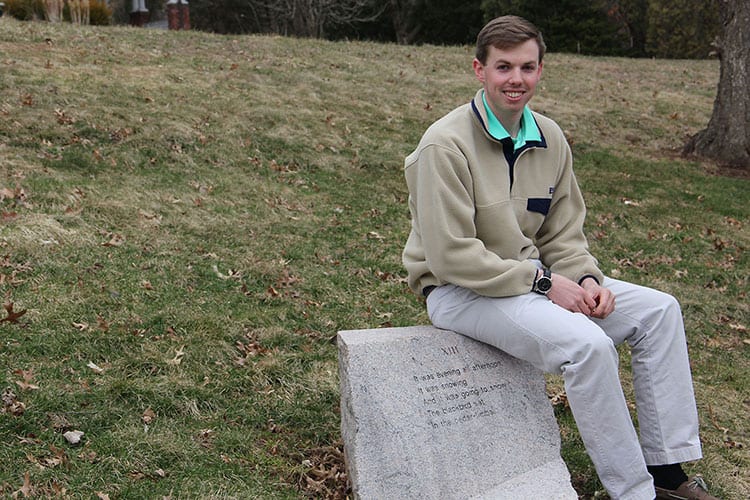Finding Meaning in Poetry and Taking a Walk to Work
 Hi everyone – I have been meeting with my thesis advisor, Dr. Bill Hogan, on a weekly basis to discuss my work and to gauge my progress on this project. He has been a huge help throughout the process. I have found it extremely beneficial to bounce my ideas off of him, to engage with his own theories about Wallace Stevens’ poetry, and to have a second set of eyes on my writing. Dr. Hogan is also interested in Stevens, but he is more focused on the poet’s treatment of nature, so it has been fruitful for me to join my own analysis with his fresh perspective in our collaborative discussions.
Hi everyone – I have been meeting with my thesis advisor, Dr. Bill Hogan, on a weekly basis to discuss my work and to gauge my progress on this project. He has been a huge help throughout the process. I have found it extremely beneficial to bounce my ideas off of him, to engage with his own theories about Wallace Stevens’ poetry, and to have a second set of eyes on my writing. Dr. Hogan is also interested in Stevens, but he is more focused on the poet’s treatment of nature, so it has been fruitful for me to join my own analysis with his fresh perspective in our collaborative discussions.
Since my last blog post, I have narrowed the scope of my independent research project slightly. The crux of my thesis paper will involve my engagement with (and analysis of) three major poems that trace the entirety of Wallace Stevens’ literary career. The first, “Sunday Morning,” is from Stevens’ earliest collection, Harmonium, and it is one of his most well-known works. “Sunday Morning” is concerned with finding meaning and beauty in a world devoid of religion. In my paper, I will argue that Stevens’ attempt to find a replacement for institutionalized belief is a fundamental religious impulse and a paradoxical movement toward God. The second major work that I will be grappling with is a mid-career moment of Stevens, which is titled “Notes toward a Supreme Fiction.” Many critics consider this to be Stevens’ opus–his “Wasteland” poem per se.
In this vastly difficult literary masterpiece, the poet simultaneously uses images and abstractions to establish his views on reality, the imagination, perception, and the power of poetry. Although there are religious topics to be explored in “Notes,” it is mostly relevant to my project because in it, Stevens tries to discover a supreme fiction that is capable of replacing religion. And while Stevens never arrived at a unifying truth at the center of reality in his poetry, he did find God at the end of his life, and I believe that the poet’s striving toward real knowledge in “Notes” can be seen as a precursor to his Catholic conversion. The last poem that I plan to analyze in-depth is the one of the last poems that Wallace Stevens ever wrote–“Of Mere Being”. In true Stevensian fashion, the poet still uses vivid images and rare abstractions to convey his perception of reality even this late in his life. However, I will argue that “Of Mere Being” is one of Stevens’ most explicitly religious poems. The language and the images that the poet employs suggest a readiness to accept God’s grace and to be welcomed into the fold. Of course, I will be using other poems from Harmonium, Transport to Summer, The Rock, and Late Poems as ancillary ammo for my argument. But, as of right now, the three aforementioned poems will form the basis of my thesis project.
I now know that my thesis will be focused on Wallace Stevens’ sacramental vision of the world as seen in his poetry. I will analyze Stevens’ poetry in the context of the Catholic sacraments and I will explain how the poet’s goal is analogous to that which takes place in a sacramental rite. Just like a Catholic priest uses words to turn material objects into divine vessels, so too did Wallace Stevens try to uncover a supreme fiction in the world through his poetic language.
I plan on visiting Stevens’ Hartford home in late April so that I can take his walk to work on a sunny day. I think that by taking a day late in the semester to explore Stevens’ city and to see his favorite natural conservancy (Elizabeth Park), it will allow me to appreciate all of the work that I have done so far and it will help me to conclude my independent research project. I plan to enjoy this day with my girlfriend and my mom, which will make the experience even more special.





